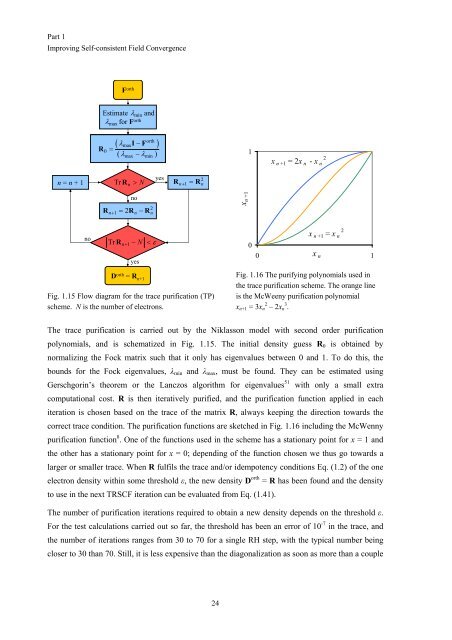Get my PhD Thesis
Get my PhD Thesis
Get my PhD Thesis
You also want an ePaper? Increase the reach of your titles
YUMPU automatically turns print PDFs into web optimized ePapers that Google loves.
Part 1<br />
Improving Self-consistent Field Convergence<br />
F orth<br />
R<br />
λ min<br />
Estimate and<br />
for F orth<br />
λ max<br />
0<br />
orth<br />
( λ<br />
max<br />
I<br />
−<br />
F<br />
)<br />
=<br />
( λ<br />
−<br />
λ<br />
)<br />
max<br />
min<br />
1<br />
x n +1 = 2x n - x n<br />
2<br />
n = n + 1<br />
Tr Rn > N<br />
yes<br />
R<br />
n+ 1 =<br />
R<br />
2<br />
n<br />
no<br />
2<br />
n+ 1 = 2 n − n<br />
R R R<br />
x n +1<br />
no<br />
Tr Rn N ε<br />
+ 1 − <<br />
yes<br />
D orth = R n+1<br />
Fig. 1.15 Flow diagram for the trace purification (TP)<br />
scheme. N is the number of electrons.<br />
0<br />
x n +1 = x n<br />
2<br />
0 x n<br />
1<br />
Fig. 1.16 The purifying polynomials used in<br />
the trace purification scheme. The orange line<br />
is the McWeeny purification polynomial<br />
x n+1 = 3x n 2 – 2x n 3 .<br />
The trace purification is carried out by the Niklasson model with second order purification<br />
polynomials, and is schematized in Fig. 1.15. The initial density guess R 0 is obtained by<br />
normalizing the Fock matrix such that it only has eigenvalues between 0 and 1. To do this, the<br />
bounds for the Fock eigenvalues, λ min and λ max , must be found. They can be estimated using<br />
Gerschgorin’s theorem or the Lanczos algorithm for eigenvalues 51 with only a small extra<br />
computational cost. R is then iteratively purified, and the purification function applied in each<br />
iteration is chosen based on the trace of the matrix R, always keeping the direction towards the<br />
correct trace condition. The purification functions are sketched in Fig. 1.16 including the McWenny<br />
purification function 8 . One of the functions used in the scheme has a stationary point for x = 1 and<br />
the other has a stationary point for x = 0; depending of the function chosen we thus go towards a<br />
larger or smaller trace. When R fulfils the trace and/or idempotency conditions Eq. (1.2) of the one<br />
electron density within some threshold ε, the new density D orth = R has been found and the density<br />
to use in the next TRSCF iteration can be evaluated from Eq. (1.41).<br />
The number of purification iterations required to obtain a new density depends on the threshold ε.<br />
For the test calculations carried out so far, the threshold has been an error of 10 -7 in the trace, and<br />
the number of iterations ranges from 30 to 70 for a single RH step, with the typical number being<br />
closer to 30 than 70. Still, it is less expensive than the diagonalization as soon as more than a couple<br />
24

















